Project 26 and 26 bis cruisers. Part of 3. Main caliber
Of course, the most discussed topic in the design of domestic light cruisers of 26 and 26-bis projects is their weaponry and, first of all, the main caliber. Not only did it give rise to numerous disputes about the classification of cruisers (light or heavy?), The guns themselves were considered to be a masterpiece of artillery, unparalleled in the world, they were declared a deafening failure of Soviet gunsmiths, from which can not even get to the peninsula of Crimea.
So, I.F. Tsvetkov in his work The Guards Cruiser Krasny Kavkaz tells about the prototype guns of the Kirov-type cruisers in the most superlative degree:
But AB Shirokorad in "Battle for the Black Sea" speaks of 180-mm guns much more derogatory:
Thus, some authors admire the power and record range of a Soviet gun, while others (critics, most of them) point out the following drawbacks:
1. Rapid barrel wear and, as a result, low durability of the latter.
2. Low shooting accuracy.
3. Low rate of fire, by virtue of which the 180-mm cannon is inferior even to 152-mm artillery systems in fire performance.
4. Low survivability of the three-gun installation due to the placement of all three guns in one cradle.
In recent years, it has become widely believed that the aforementioned deficiencies made our 180-mm guns almost inefficient. Without pretending to the ultimate truth, we will try to figure out how justified these claims are to the main caliber of our cruisers.
Main weapon Each 26 or 26-bis cruisers made up nine 180-mm / 57 B-1-P cannons and, to begin with, tell you history the emergence of this artillery system as most sources today provide it.
The B-1-P was a “descendant”, or rather, an upgrade of the X-NUMX-mm / 180 cannon, the B-60-K, developed in 1. Then the national design idea swept aside at a lot. First, it was decided to get a record of ballistics in order to shoot a 1931 kg projectile with an initial velocity in 100 m / s. Secondly, it was planned to achieve a very high rate of fire - 1000 rds / min, which was required to ensure loading at any angle of elevation.
The large-caliber guns of those times did not have such luxury, charging at a fixed angle, i.e. after the shot, the gun should have been lowered to the loading angle, loaded, given the desired sight again and only then fired, and all this, of course, took a lot of time. Charging at any elevation angle made it possible to shorten the reload cycle and increase the rate of fire, but for this, the designers had to pile up a rammer on the swinging part of the gun and provide for a very bulky ammunition supply structure. In addition, it was decided to switch from cartridge loading to split-shell loading, as was customary for large German guns fleet, which allowed the use of a wedge shutter, which also reduces the recharge time. But at the same time, when designing the B-1-K, there were also very archaic decisions - the barrel was made fastened, i.e. did not have a liner, which is why after his execution it was required to change the body of the gun. In addition, the barrel was not purged, due to which powder gases entered the tower, a rangefinder was not installed, and there were other disadvantages.
The first experience of the development of the domestic marine medium-caliber artillery system turned out to be negative, since the parameters specified in the design were not achieved. So, to ensure the required ballistics, the pressure in the barrel should have been 4 000 kg / sq. cm, but steel that could withstand such pressure could not be created. As a result, the pressure in the barrel had to be reduced to 3 200 kg / sq. cm, which provided 97,5-kg projectile initial speed 920 m / s. However, with such a decrease, the barrel survivability was extremely low - on the order of 50-60 shots. The practical rate of fire with great difficulty brought to 4 shots / min. but in general, neither the B-1-K nor the single-gun turret in which this artillery system was mounted on the cruiser Krasny Kavkaz were considered successful.
The fleet needed a more advanced gun and made it on the basis of the B-1-K, but now its design was more conservative, abandoning most of the innovations that did not justify themselves. The gun was charged at a fixed angle in 6,5 hail, from a wedge gate and separate sleeve loading returned to the cap and piston gate. Since the power of the gun, compared with the initial requirements, had to be reduced from planned 1000 m / s for 100 kg of projectile to 920 m / s for 97,5-kg of projectile, the barrel length was reduced from 60 to 57 calibers. The resulting gun was called the B-1-P (the last letter meant the type of bolt “K” - wedge, “P” - piston), and at first the new artillery system did not have any other differences with the B-1-K: for example, its barrel also performed bonded.
But soon B-1-P underwent a series of upgrades. At first, the USSR acquired equipment for the production of liners for naval artillery from Italy, and in 1934, the first 180-mm lined gun was already tested at the test site, and later the fleet ordered only such cannons. But even with lined B-1Ps, the barrel survivability grew only slightly, reaching 60-70 shots, against 50-60 shots B-1-K. This was unacceptable, and then the vitality of the trunks was adjusted by increasing the depth of the rifling. The deep-rifled liner now held up not 60-70, but whole 320 shots.
It would seem that an acceptable indicator of survivability was achieved, but it was not there: it turns out that Soviet sources do not mention one very interesting detail: this vitality was not at all provided by the depth of the rifling, but ... by changing the criteria for barrel wear. For B-1-K and B-1-K with fine cutting, the barrel was considered shot if the projectile lost 4% of its original speed, but for lined deep-cut barrels this figure was increased to 10%! It turns out that in actual fact nothing much has changed, and the desired indicator was simply “stretched” by an increase in the wear criterion. And given Shirokorad’s categorical statements about the extremely low accuracy of our guns at large distances (“getting into a moving battleship or cruiser ... can only be completely random”), readers interested in the history of the Russian fleet had a completely unattractive picture in which, what is most regrettable, very easy to believe.
It turned out that the developers of the B-1-K and B-1-P in the pursuit of records overloaded the cannon with an excessively powerful charge and heavy projectile, the artillery system simply could not withstand the loads for it for a long time (such guns are called over-powered) . From this, the trunk was subjected to extremely rapid burnout, as a result of which the accuracy and precision of the fire was quickly lost. At the same time, the gun also did not differ in accuracy in the “non-shot” state, and taking into account the fact that the accuracy dropped after several dozen shots ... And if we also remember that three barrels in one cradle were too close to each other, which caused a volley on The projectiles from the neighboring barrels, which sent the correct trajectory to it, hit the last flight of the projectiles ... What is the pursuit of “faster, higher, stronger”, so characteristic of the 30 of the last century, which once again resulted in solid points iratelstvo and fraud. And the sailors got a completely useless weapon.
Well, let's go from afar. Here is AB Shirokorad writes: "The median deviation in range was over 180 m." What is the median deviation and where does it come from? Recall the basics of artillery case. If you hover a gun at some point on the ground and, without changing the sight, make some shots, the shells fired from it will not go one after the other to the aiming point (like Robin Hood’s arrows split the other in the center of the target) fall some distance away from her. This is due to the fact that each shot is strictly individual: the mass of the projectile differs by a fraction of a percent, the quantity, quality and temperature of the powder in the charge vary slightly, the sight gets lost in thousandths of a degree, and gusts affect the flying projectile even a little - just different than the previous one - and eventually the projectile will fall a little further or a little closer, a little to the left or a little to the right from the aiming point.
The area in which the shells fall is called the ellipse of dispersion. The center of the ellipse is the aiming point where the gun was aimed. And this ellipse of dispersion has its own laws.
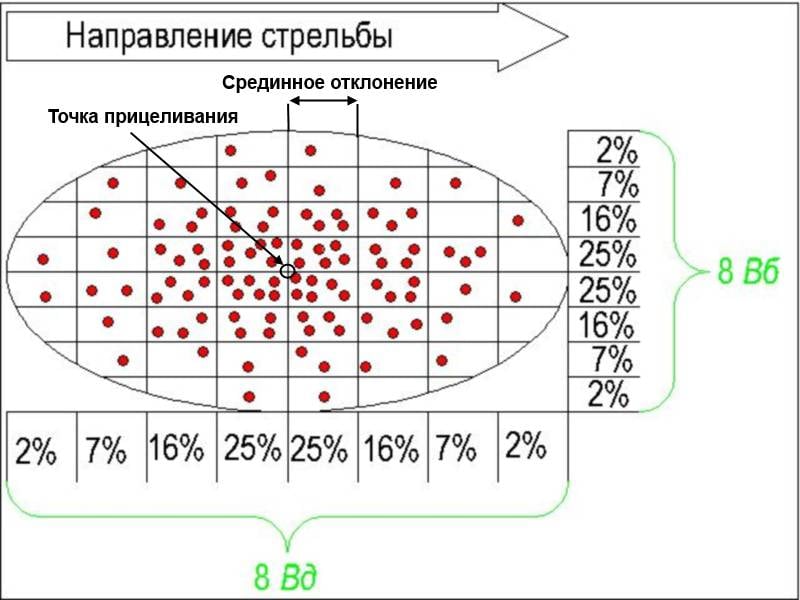
If the ellipse is divided into eight parts along the direction of the projectile, then 50% of all the projectiles will fall into two parts that directly adjoin the aiming point. This law works for any artillery system. Of course, if you release 20 shells from a cannon without changing the sight, it may well turn out that the two specified parts of the ellipse will fall on 10, and 9 or 12 shells, but the more projectiles will be released, the closer to the 50% will be the final result. One of these parts is called the median deviation. That is, if the median deviation at a distance of 18 kilometers from a gun is 100 meters, it means that if you precisely point the gun at the target located in 18 km from the gun, then 50% of the shells dropped at the 200 meter segment, the center which will be the aiming point.
The larger the median deviation, the larger the ellipse of dispersion, the smaller the median deviation, the greater the chances of the projectile hitting the target. But what does its size depend on? Of course, the accuracy of the gun, which, in turn, affect the quality of the manufacture of guns and shells. Still - from the distance of fire: if you do not delve into some nuances that are unnecessary for a non-specialist, then the greater the distance of the fire, the lower the accuracy and the greater the median deviation. Accordingly, the median deviation is a very good indicator characterizing the accuracy of the artillery system. And in order to understand what the B-1-P was in terms of accuracy, it would be nice to compare its median deviations with the guns of foreign powers ... but it turned out to be quite difficult.
The fact is that in the usual references such data is not found, it is very specialized information. Thus, for the Soviet artillery systems, the median deviations of a specific gun are contained in a special document “Basic firing tables”, which was used by gunners to control the fire. Some "Tables" can be found on the Internet, and the author of this article managed to get the "Tables" of domestic 180-mm guns.
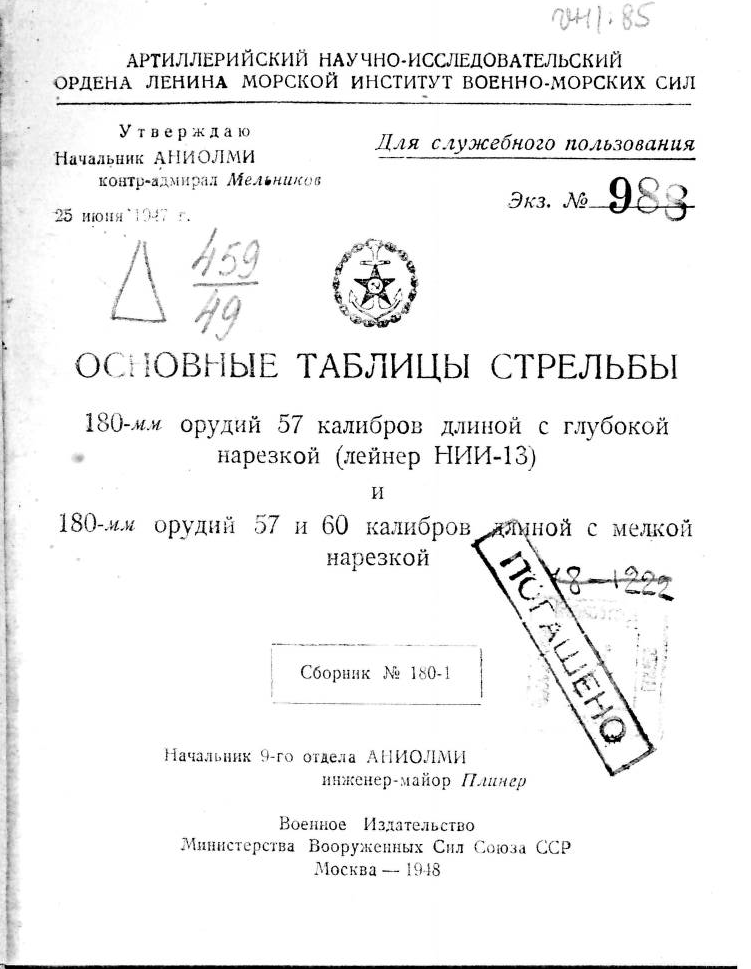
But with foreign naval guns, the situation is much worse - perhaps somewhere in the network there is such data, but, alas, it was not possible to find them. So with what to compare B-1-P?
In the history of the national fleet there were artillery systems that never caused any complaints from naval historians. Such, for example, was the 203-mm / 50 gun, on the basis of which, in fact, was designed B-1-K. Or the famous Obukhov 305-mm / 52, which armed with the battleships of the types "Sevastopol" and "Empress Maria" - it is widely considered an exemplary killing machine. No one has ever reproached the said artillery systems for the excessive dispersion of projectiles, and the data on their median deviations are in Goncharov's "Course of naval tactics" (1932 g).
Note: shooting distances are specified in cable and converted into meters for easy perception. Mean deviations in documents are indicated in fathoms, and also, for convenience, are converted to meters (1 fathom = 6 ft, 1 ft = 30,4 cm)
Thus, we see that the domestic B-1-P is much more accurate than the "royal" cannons. In fact, our 180-mm artillery system on the 90 kbt beats more accurately than the 305-mm dreadnought cannon - on the 70 kbt, and even with the 203-mm / 50 - no comparison at all! Of course, progress does not stand still, and perhaps (since the author could not find data on the median dispersion of imported guns) artillery from other countries shot even more accurately, but if the accuracy of 305-mm guns (with far worse fire control systems) was considered sufficient for defeats of surface targets, then why would we consider a much more accurate 180-mm gun "stupid"?
And those fragmentary data on the accuracy of foreign guns, which are still in the network, do not confirm the hypothesis of poor accuracy of the B-1-P. For example, there is data on the German field 105-mm gun - its median deviation at a distance of 16 km is 73 m (for B-1-P at this distance - 53 m), and at the limit for her 19 km the German has 108 m (B -1-P - 64 m). Of course, it is impossible to compare the land “weave” with a naval gun of almost twice the caliber so “in the forehead”, but still these figures can give some idea.
The attentive reader will note that the “Main firing tables” I have provided are compiled in the 1948 year, i.e. after the war. What if by that time in the USSR they had learned to make some better liners than the pre-war ones? But in fact, the strenuous-combat shooting tables were compiled on the basis of the actual shooting in September of 1940 G .:
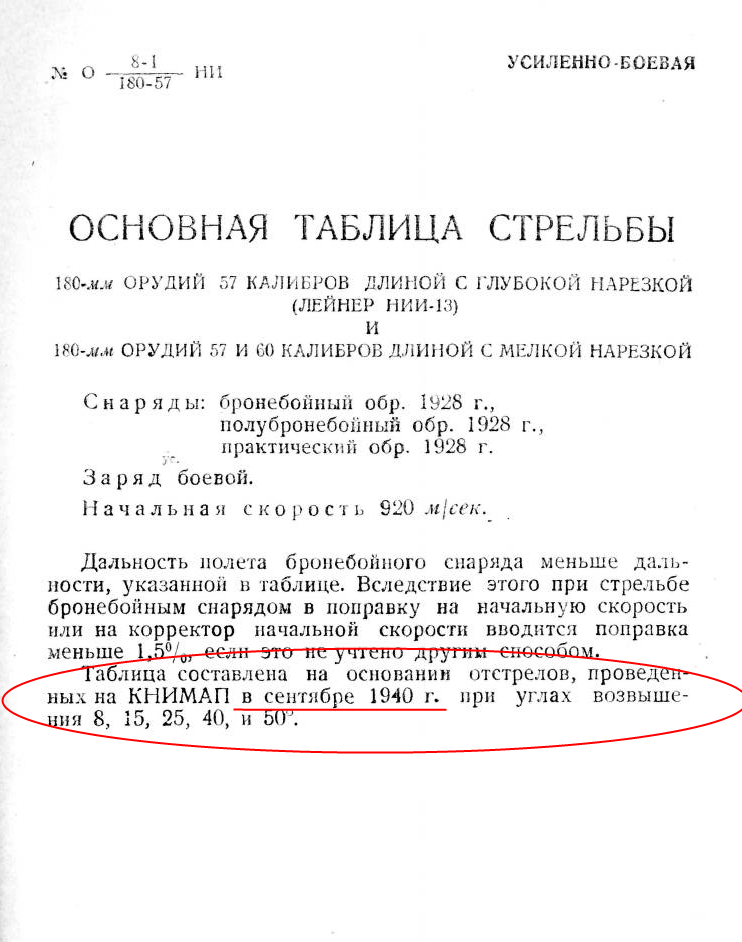
In addition, this screenshot clearly confirms that the “Tables” used not calculated, but actual values based on the results of the firing.
But what about the low survivability of our guns? After all, our guns are re-forced, their trunks burn out for several dozen shots, the accuracy of fire quickly falls and then the median deviations exceed their tabular values ... Stop. And why did we decide that our 180-mm guns had little survivability?
“But how ?! - the reader exclaims. - After all, our designers, in pursuit of record-breaking characteristics, managed to bring the pressure in the barrel channel right up to 3 200 kg / sq. see why the trunks quickly burned out! ”
But what is interesting is that the German 203-mm / 60 gun model SkL / 60 Mod.C 34, which armed the Admiral Hipper-type cruiser, had exactly the same pressure - 3 200 kg / sq. see It was another monster firing 122 kg shells with an initial speed of 925 m / s. However, no one has ever called him recaptured or inaccurate, on the contrary - the gun was considered to be a very prominent representative of average caliber naval artillery. At the same time, this gun convincingly demonstrated its qualities in a battle in the Danish Strait. The heavy cruiser "Prince Eugen", firing at a distance from 70 to 100 KB for 24 minutes, achieved at least one hit in the "Hood" and four hits in the "Prince of Wells." At the same time, the barrel survivability (according to various data) ranged from 500 to 510 shots.
You can, of course, say that German industry was better than the Soviet and allowed to produce better-quality weapons. But not much! Interestingly, according to some sources (Yuren V. “The death of the battle cruiser“ Hood ”), the median deviation of the German 203-mm cannon roughly corresponds to (and even slightly higher) that of the Soviet 180-mm artillery system.
Depth of rifling? Yes, the B-1-K rifles have 1,35 mm, while the B-1-P has whole 3,6 mm, and such growth seems to be suspicious. But here's the thing: the German 203-mm / 60 had a depth of rifling 2,4 mm, i.e. significantly more than the B-1-K, although almost one and a half times less than the B-1-P. Those. the increase in the depth of the rifling is to a certain extent justified, since for their performance characteristics of the B-1-K they were simply underestimated (although, perhaps, they are somewhat overestimated in the B-1-P). You can still remember that the 152-mm gun B-38 (the accuracy of which, again, no one ever complained) had a depth of rifling 3,05 mm
But what about the increase in the execution criteria for guns? After all, there is an absolutely exact fact: for the B-1-K 100%, barrel wear was considered when the projectile speed dropped by 4%, and for the B-1-P - the speed drop was allowed as much in 10%! So, all the same eyewash?
Let me offer you, dear readers, a hypothesis that does not claim to be the absolute truth (the author of the article is not an expert in artillery), but explains well the increase in wear criteria for the B-1-P.
First. The author of this article tried to find out what criteria for the execution of guns were used abroad - this would help to understand what is wrong with the B-1-P. However, such information could not be found. But L. Goncharov in his work “The course of naval tactics. Artillery and Armor »1932 g, which generally speaking served as an artillery training tool, indicates a single criterion for the survivability of a weapon -“ the loss of stability by a projectile ”. In other words, the gun cannot be shot so much that its projectile starts to tumble in flight, because in this case, if it hits, it can either collapse before the explosion, or the fuse will not work. It is also clear that one should expect a breakdown of armor from an armor-piercing projectile if it hits the target with its “head” part, and does not plop about it flat.
Second. By itself, the criterion of wear of the barrel of Soviet cannons looks utterly surprising. Well, the speed fell on 10% of the projectile, so what? Is it difficult to foresee an appropriate amendment when shooting? Yes, not at all - the same “General firing tables” give a whole set of amendments for each percent drop in the velocity of projectiles, from one to ten. Accordingly, it is possible to determine the corrections for both 12- and 15-percent drops, there would be a desire. But if we assume that the change in velocity of the projectile itself is not critical, but with a corresponding drop in speed (4% for B-1-K and 10% for B-1-P) something happens that interferes with the normal firing of the gun - then everything becomes clear.
The third. At B-1-P the depth of rifling is increased. What for? Why do we need rifle gun? The answer is simple - a projectile “twisted” in cuts has greater stability in flight, better range and accuracy.
Fourth. What happens when a shot is made? The shell is made of very strong steel, over which is installed the so-called "belt" of mild steel. Mild steel "pressed" into the grooves and spins the projectile. Thus, the barrel “in depth” of the rifling interacts with the soft steel of the “shell belt”, while the “over the top” rifle interacts with the very hard steel of the projectile itself.
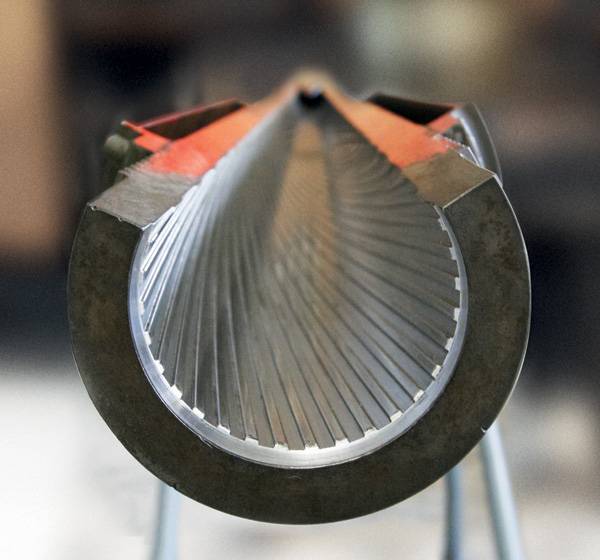
The fifth. Based on the foregoing, we can assume that when firing from a cannon, the depth of rifling decreases. Just because the "top" is erased on hard steel of the projectile faster than the "bottom" - on soft.
And if our assumption is true, then the “casket” with the increase in the depth of rifling opens very simply. The shallow rifts of the B-1-K were erased very quickly, and already with a drop in speed of 4%, the projectile ceased to “twist” with them sufficiently, and this is expressed in the fact that the projectile ceased to “behave” in flight as it should be. Perhaps he was losing stability, or sharply dropped accuracy. A tool with deeper cuts retains the ability to adequately “twist” the projectile even if its initial velocity drops in 4%, and in 5% and in 8%, and so on up to 10%. Thus, no reduction in survivability criteria for B-1-P as compared to B-1-P did not occur.
Of course, all of the above, although it explains very well the reason for the increase in the depth of the rifling, and the reduction in the survivability criteria for the B-1-P cannon, it is still nothing more than a hypothesis, and a person very far from artillery.
An interesting nuance. Reading the sources about the Soviet cruisers, it can be concluded that the shot (that is, the projectile and charge) in which the 97,5 kg projectile was given the initial speed in 920 m / s is the main for our 180-mm guns. But it is not. The initial speed in 920 m / s was provided by a reinforced-combat charge, a mass of 37,5 kg, but apart from it there was a combat (mass -30 kg, accelerated 97,5 kg projectile to a speed of 800 m / s), lower-combat (28 kg, 720 m / s ) and reduced (18 kg, 600 m / s). Of course, with a decrease in the initial speed, the barrel survivability grew, but the armor penetration and firing range fell. The latter, however, is not so significant - if the strenuous combat provided the ultimate range of fire at 203 kb, then the main battle charge was “thrown” by the 180-mm cannon at 156 kbt, which was more than enough for any naval combat.
I should note that in some sources it is indicated that the survivability of the barrel of the 180-mm cannon B-1-P in the 320 shots is provided by using a combat charge rather than a reinforced combat one. But, apparently, this is a mistake. According to the "Instructions for determining the wear of 180 / 57 channels of naval artillery cannons" 1940 g (RGAVMF P-891 Foundation, No. 1294, op.5 d.2150), as quoted on the Internet, 90 battle-fighting V = 100 / s or 320 for combat charge (920 m / s) ". Unfortunately, the author of the article does not have the opportunity to verify the accuracy of the quotation, since he does not have a copy of the “Instructions” (or the opportunity to visit the Russian State Archive of the Navy). But I want to note that such data correlate much better with the survivability indicators of the German 640-mm gun than the idea that with equal pressure inside the barrel (800 203 kg / sq. Cm), the Soviet 3-mm had the vitality of all 200 shots against 180 -70 from German.
In general, it can be stated that the accuracy of the Soviet B-1-P cannon is quite sufficient for confident destruction of naval targets at any reasonable range of artillery combat, and although questions on its survivability remain, most likely the publications of recent years have greatly thickened paint on this the issue.
We turn to the towers. The Kirov and Maxim Gorky-class cruisers each carried three MK-3-180 three-gun turrets. The latter are traditionally blamed for the “single-faced” design - all three guns of the B-1-P were placed in a single cradle (like the Italian cruisers, the only difference is that the Italians used two-turrets). There are two claims to this location:
1. Low survivability installation. When knocking out the cradle, all three guns become inefficient, while for an installation with individual guidance of each gun, damage to one of the cradles would disable only one gun.
2. Because of the small distance between the trunks during a salvo firing, the projectile that just left its barrel is exposed to gases from neighboring barrels and “knocks” its trajectory, which is why the dispersion greatly increases and the accuracy of shooting is lost.
Let us see what our designers have lost and what they acquired, using the “Italian” scheme.
Just want to say that the claim about the survivability of the installation is somewhat contrived. Theoretically, of course, it is possible that one or two tower guns fail, and the rest continue to shoot, but in practice this almost never happened. Perhaps the only such case is the damage to the turret of the battle cruiser Lion, when the left gun failed and the right one continued to fire. In other cases (when one turret gun fired, and the other did not) the damage is usually not connected in any way with a vertical pickup device (for example, a direct hit was broken off a piece of the barrel). Having received similar damage to one weapon, the other guns MK-3-180 could well continue the battle.
The second claim is much more weighty. Indeed, having the distance between the axes of the guns only 82, see MK-3-180 could not conduct salvo firing without some loss in accuracy. But here there are two important nuances.
Firstly, the fact is that shooting by full salvoes before World War I was practically never practiced. This was due to the peculiarities of the conduct of fire fighting - in order to ensure effective zeroing at least four guns were needed in the salvo. But if more of them were firing, then this helped little the artillery officer of the firing ship. Accordingly, a ship with 8-9 guns of the main caliber usually fought with half-salts, each of which involved 4-5 guns. That is why, in the opinion of naval artillerymen, the most optimal layout of the GK guns was four two-gun turrets - two in the bow and the stern. In this case, the ship could shoot at the bow and stern with full volleys of the bow (stern) towers, and during firing on board - with half-salts, each of the four towers firing from one gun (the second one was reloading at that time). The situation was similar in the Soviet fleet, so the Kirov could well fire, alternating four and five-guns
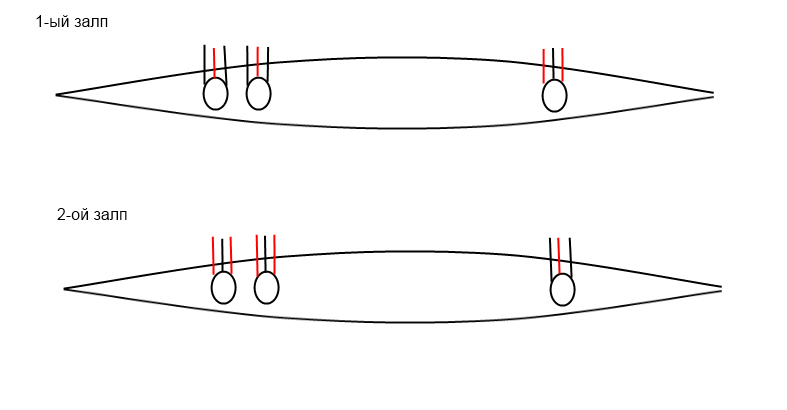
At the same time, the distance between the barrels of firing guns increased significantly and was 162 cm. This, of course, did not reach 190 cm for 203-mm towers of Japanese heavy cruisers, and even more so - to 216 cm of the Admiral Hipper-type cruiser towers, but still was not an extremely small value.
In addition, it should be borne in mind that it is still not very clear how much fire accuracy decreases during salvo firing with the "one-man" placement of guns. Usually, the monstrous dispersion of the guns of the Italian fleet is remembered on this occasion, but according to many researchers, it’s not so much the blame for placing all the barrels in one cradle as the ugly quality of Italian projectiles and charges that differed greatly in weight. If high-quality projectiles were used (shells made in Germany were tested), the dispersion turned out to be quite acceptable.
But not only Italian and Soviet tower installations put all the tools in one cradle. The Americans also sinned - the guns of the first four series of heavy cruisers (Pensacola, Northampton, Portland, New Orleans types) and even some of the battleships (Nevada and Pennsylvania types) were also mounted in one cradle. However, the Americans came out of this position, placing automatic time-delay machines in the towers - now the guns were fired with a delay of one hundredth of a second, which significantly increased the accuracy of the shooting. "On the Internet," the author came up with allegations that such gadgets were installed on the MK-3-180, however, no documentary evidence was found for this.
But still, according to the author, "one-man" tower installations have another significant drawback. The fact is that in the Soviet fleet (and not only in it, the method described further was known during the time of the first world war) there existed such a concept as shooting by a “ledge”. Without going into unnecessary details, we note that earlier, when shooting with a “fork,” every next salvo (half-salvo) was made after observing the fall of the projectiles of the previous one and making the corresponding sight adjustment, i.e between volleys a lot of time passed. But when shooting the “ledge” half of the guns, one sight was given, the second half was slightly modified, with an increased (or reduced) range. Then he made two half-heads with a difference of a few seconds. As a result, an artillery officer could assess the position of the enemy ship relative to the fall of two half-salts, and it turned out that it was much more convenient and quicker to determine the corrections to the sight. On the whole, shooting with a “ledge” made it possible to shoot faster than when shooting with a “fork”.
But shooting a "ledge" from "one-man" installations is difficult. There is nothing difficult in an ordinary turret - one angle of elevation was set for one gun, another angle was different, and in MK-3-180, when aiming, all the guns got the same angle. Of course, it was possible to make a half-hub, then change the tip and make the second one, but it was all slower and more difficult.
However, the "single-faced" installations had their merits. Placing guns on different cradles faced the problem of misalignment of the axes of the guns: this is a situation when the guns in the turret are exposed to the same sight, but because of the mismatch of the position of the individual cradles, they have slightly different elevation angles and as a result - increased scatter in the volley . And, of course, "one-man" tower installations greatly won in terms of weight and dimensions.
For example, the rotating part of the three-bomber 180-mm turret of the cruiser Kirov was only 147 tons (247 t is the total weight of the installation, taking into account the barbet mass), while the tower was protected by 50 mm armor plates. But the rotating part of the German three-gun 152-mm turret, in which the guns were placed individually, had a weight of almost 137 tons, while its front plates had only 30 mm thickness, and the sides and roof were generally 20 mm. The rotating part of the 152-mm two-gun British turret of the Linder-type cruisers had only an inch of protection, but at the same time weighed 96,5 tons.
In addition, each Soviet MK-3-180 had its own rangefinder and its own automatic firing, i.e. actually duplicated centralized fire control, albeit in miniature. Neither the English nor the German towers had any rangefinders, nor (even more so!) Firing rifles.
It is interesting to compare the MK-3-180 with the three-gun turrets 152-mm guns of the cruiser Edinburgh. Those had slightly better reservations (board and roof - the same 50 mm, but the front plate - 102 mm of armor) did not have range finders or shooting machines, but their rotating part weighed 178 tons. However, the weight advantages of the Soviet towers did not end there. After all, in addition to the rotating part, there are also non-rotating structural elements, of which barbet has the greatest mass — an armored “well” connecting the tower and reaching either the armored decks or the cellars. Barbet is absolutely necessary, as it protects the feeders of projectiles and charges, preventing fire from entering the artillery range.
But the mass of barbet is very large. So, for example, the mass of barbets in the 68 cruiser (“Chapaev”) was 592 t, while the lengthy 100 mm armor belt weighed almost the same - 689 t. A very important factor affecting the barbet mass was its diameter, and The relatively small-sized MK-3-180 approximately corresponded to that of three-gun 152-mm turrets with tools in individual cradles, but an attempt to place 180-mm in different cradles would lead to a significant increase in diameter, and as a result - barbet mass.
The conclusions are as follows. In general, the tower with the guns in one cradle, though not fatal, still loses in combat qualities of the tower installation with separate vertical guidance of guns. But in the case when the displacement of the ship is subject to restriction, the use of "one-man" towers allows for the same fire weight to provide greater fire power. In other words, of course it would be better to put towers with guns in individual cradles on the Kirov and Maxim Gorky-type cruisers, but at the same time one would expect a significant increase in displacement. And in the existing scales on our cruisers it was possible to install either three three-gun turrets with 180-mm cannons in one cradle (as it was done) or three two-gun turrets with 180-mm guns in different cradles, or the same number of three-gun 152-mm towers with guns in different cradles. Obviously, despite some shortcomings, 9 * 180-mm guns are significantly better than 6 * 180-mm or 9 * 152-mm.
On the subject of the main caliber one should also describe the problems with the MK-3-180 rate of fire, the shells that our 180-mm guns fired, and the fire control system. Alas, due to the large amount of material it was not possible to fit everything into one article, and therefore ...
To be continued!
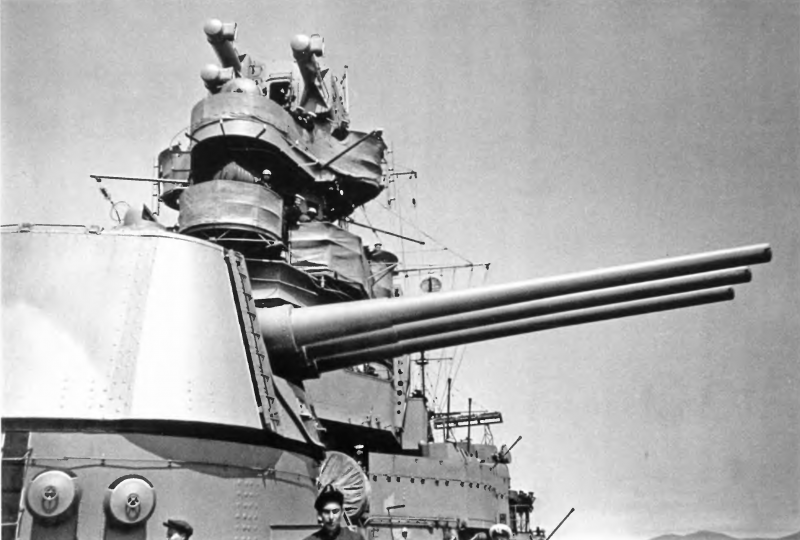
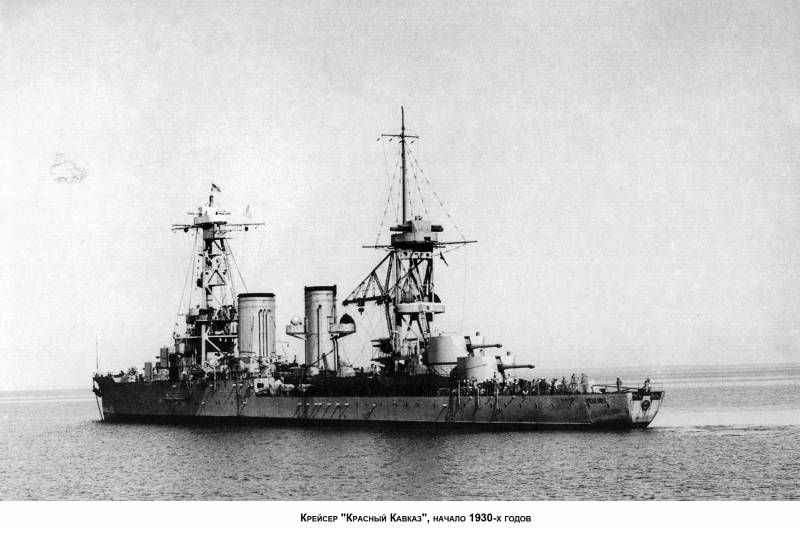

Information